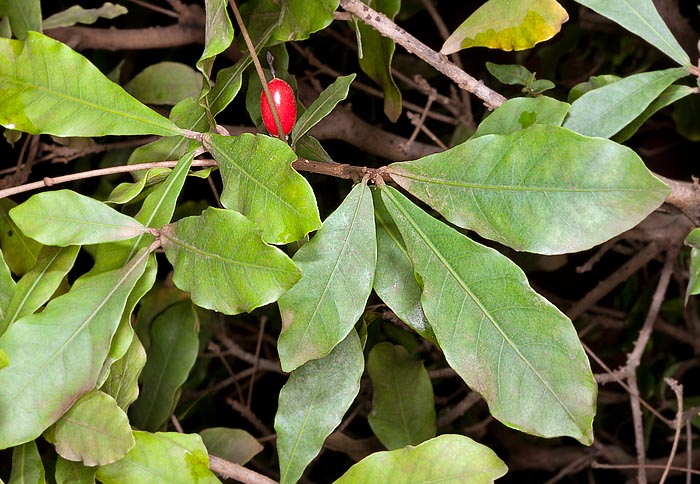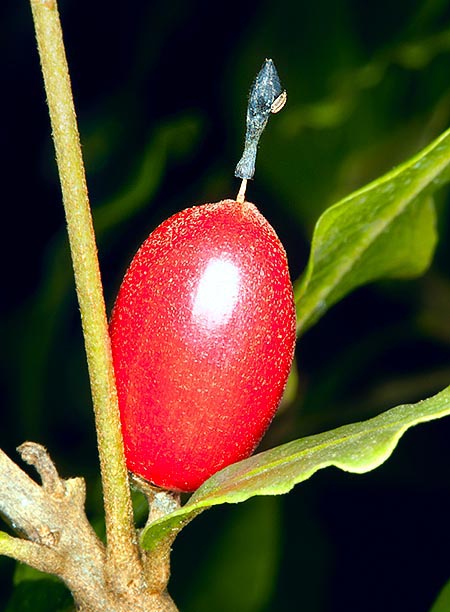Family : Sapotaceae

Text © Pietro Puccio

English translation by Mario Beltramini

Synsepalum dulcificum is a 2-5 m evergreen shrub for tropical climates © Giuseppe Mazza
The name of the genus is the combination of the Greek preposition “syn” = with, together, and of the Latin term “sepalum” = sepal, with reference to the more than half united sepals; the name of the species is the Latin adjective “dulcificus, a, um” = which sweetens, with obvious reference.
Common names: magic berry, miracle berry, miracle fruit, miraculous berry, miraculous fruit, sweet berry (English); fruit miracle, fruit miraculeux (French); albero del miracolo, frutto miracoloso (Italian); fruta-do-milagre (Portuguese); fruta milagrosa, matasabor (Spanish); Wunderbeere, Mirakelfrucht genannt (German).
The Synsepalum dulcificum (Schumach. & Thonn.) Daniell (1852) is a much ramified evergreen shrub, 2-5 m tall, with thick conical foliage and leaves grouped at the extremity of the branches, on short petiole, simple and alternate, obovate with entire margin, 10-15 cm long and 3,5-5 cm broad, initially of orange to red colour, then dark green, rather coriaceous.
Hermaphrodite flowers in axillary groups bent downwards, about 1 cm long and of 0,5 cm of diameter, with pubescent funnelform calyx with 5 lobes with rounded apex and 5 petals corolla of cream white when opening, then progressively, reddish brown. The fruits, which remain long time on the plant, are ellipsoid of bright red colour when ripe, about 2 cm long and 1 cm broad, containing only one glossy blackish brown seed, about 1,5 cm long, surrounded by a thin layer of pulp.

The 2 cm fruits modify the taste perception © Giuseppe Mazza
Slow-growing species that owes its reputation to the particular property of its fruits, but which ha undoubted ornamental characteristics, cultivable in open air in the tropical and humid subtropical climate zones, temperatures around or little less than 0 °C can cause serious damage. It prefers a slightly shaded position, even if adult plants can stand full sun provided not particularly intense, and acidic soil (pH 4,5-5,8), as it does not survive in the alkaline ones, rich of organic substance, perfectly draining and kept humid. The fertilizations, in spring-summer, are to be done with balanced products for acidophilic plants with addition of microelements. It flowers and fructifies almost continuously.
Where the climate does not allow the open air permanence during the whole year, it can be cultivated in pot in soil formed by acidic peat and coarse siliceous sand or perlite, kept humid, but without stagnations, in very luminous position, and with lowest temperatures over the 14 °C; it requires a high atmospheric humidity, are useful nebulisations with not calcareous water if the ambient is rather dry. The presence of chlorine in the water is harmful for the plant, in case, let rest the water for 24 hors before watering.
The pulp of the fruit, by itself almost tasteless, if chewed for some minutes does not produce any effect, but if, after this, in 1-2 hours, we drink liquids or chew acid foods, these ones are perceived as sweet. The responsible of this temporary and partial alteration of the taste is a glycoprotein, which has been called “miraculin”, which in neutral ambient does not have any effect, but in presence of acids affects the receptors present on the tastebuds thus perceiving as sweet the acid substances.
It is not therefore a sweetener, with the side effects that these may have, but it has the same result in the perception of the taste. The pulp of the fruit is to be chewed short time after its harvesting, one day or little more, after which it quickly loses its efficacy, so, it is necessary to have available a plant in fruit, unless using the pulp, lyophilized immediately after the harvest and commercialized in tablets, that has the same action of the fresh fruit.
Synonyms: Bumelia dulcifica Schumach. & Thonn. (1827); Sideroxylon dulcificum (Schumach. & Thonn.) A.DC. (1844); Bakeriella dulcifica (Schumach. & Thonn.) Dubard (1912); Synsepalum glycydora Wernham (1917); Pouteria dulcifica (Schumach. & Thonn.) Baehni (1942); Richardella dulcifica (Schumach. & Thonn.) Baehni (1965).
→ To appreciate the biodiversity within SAPOTACEAE family please click here.
